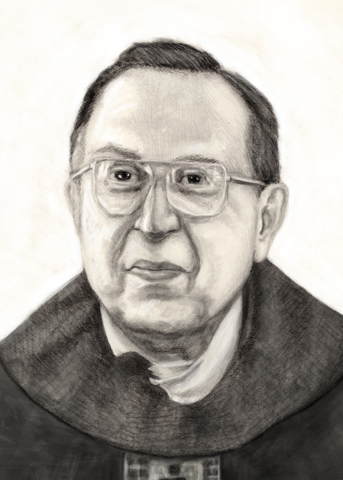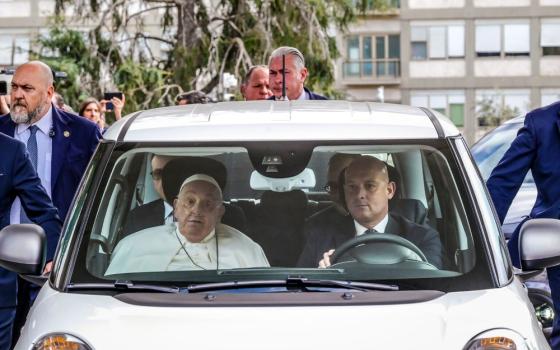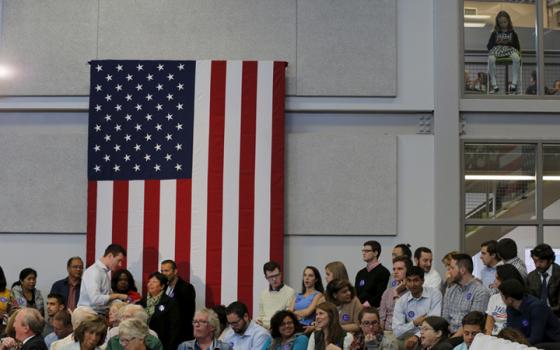
Sketch of Msgr. Ignatius Roppolo by Jonathan Hodge
He didn't grab headlines or call attention to himself. Not even when, at age 77, he fearlessly refused to leave terminally ill patients in a smelly, dark and sweltering New Orleans hospital flooded by Hurricane Katrina.
But at his funeral Mass on May 5, Msgr. Ignatius Roppolo finally took center stage as hundreds filled St. Rita's church in New Orleans to mourn the passing and to celebrate the life of the parish priest and hospital chaplain they had come to cherish.
"All that he did was never about him," said homilist Msgr. Doug Doussan*. "He was a giant of dedication to God and a compassionate, selfless servant of God's people."
Roppolo was remembered as a good shepherd, a healer, a priest's priest. One who did not disturb the universe, but changed lives one at a time with his extraordinary ability to listen and tap people's gifts.
A longtime voice for peace and social justice, Roppolo was a catalyst in integrating Catholic schools. He broke new ground in the archdiocese by sharing power in the 1960s, giving up his right as pastor to be the sole decision-maker. And he empowered the laity to such a degree that the archdiocese often had great difficulty finding someone to step into his shoes.
"He brought people together. He made everyone feel special, like you were his best friend. He brought out the best in you," said Matt Rousso, a longtime friend and colleague who delivered a remembrance at the Mass.
When some tried to call him "monsignor," Rousso said, "He would have nothing of it. He was just Ignatius -- our brother and our friend."
"For 60 years, he touched the hearts and minds of so many people" said Archbishop Gregory Aymond, who concelebrated the Mass with scores of priests. "He served in almost every office of the diocese."
Holding Roppolo's chalice high in the air, the archbishop asked, "Who will pick up his chalice? Who will follow in this great man's footsteps?"
The New Orleans-born priest, who died April 29 at age 85, had been gradually slipping away for the past several years with Parkinson's disease.
"Death came as a blessing to Ignatius because it put an end to his years of struggle," Doussan said. "In this Easter season ... in the presence of the risen Lord ... in the midst of our sorrow, we rejoice."
As a chaplain, Roppolo was no stranger to death. And when he became the director of the clinical pastoral care program at Notre Dame Seminary, he passed on what he had learned about being present to people in clinical settings.
He saw the chaplain's role as accompanying people at a critical point in their life's journey, sowing seeds for spiritual and emotional healing.
He never pretended to have the answers and never gave false hope. He would try to break the conspiracy of silence about impending death, encouraging patients to talk about their fears. Most patients, he believed, want honesty.
"I tried to get myself out of the way," Roppolo would say. "I knew the answer is never within me, but within them." He would let pauses linger and often turn questions back on the patient, saying, "What I think isn't important; it's what you think."
He would combine the art of listening and the power of story to bring about healing. He encouraged people to look at their lives as a complete story, not in chapters, in order to grasp its meaning, to see setbacks as a plot complication, not an ending.
Often, he encouraged patients to vent their anger at God, saying there are no Easters in life without Good Fridays, that illness can bring about a spiritual healing and rebirth that helps you let go of lesser things and reset your priorities.
When asked, he admitted fearing death himself: "Even Jesus feared death ... But I don't believe in death without resurrection."
Roppolo's evolving philosophy later carried over to his approach to confession. After granting absolution, he would often ask people about the blessings in their lives because "if they just confess their sins, they only see problems, failures."
His outlook had been formed by years as a parish priest and his countless experiences dealing with strife and conflict. The archdiocese had often assigned him to trouble spots.
In 1967, he was made pastor of the racially tense St. Joseph the Worker Catholic Church in suburban Marrero, La. A few years before he arrived, three black teenagers sat in the white-only pews near the altar; two were beaten with tire irons.
Roppolo walked into a firestorm over Catholic school integration. Most of the white families had taken their children out of the parish school. Doussan, who later took over as pastor there, said Roppolo "visited all these families and won most of them back. His boldness and courage ... saved the school."
Doussan, Rousso and St. Joseph Sr. Margaret Maggio, the director of religious education at the parish, explained Roppolo's "servant leadership" style as one that rejects a top-down model in favor of listening, building community and sharing power.
He asked parishioners to set up informational gatherings at their homes where he would ask them three questions: What has your journey as a parish been? Where is that journey now? What are your hopes for the future? He might also ask parishioners what three things they would do if they were the new pastor.
He would take copious notes, and after meeting with 200 or more parishioners, he'd announce from the pulpit that he'd been doing a lot of listening, and this is what he'd heard. As he listed their points, he would get nods from astonished parishioners.
To further move away from an authoritarian leadership style, Roppolo broke new ground by establishing a team ministry, sharing his decision-making with his two associate priests.
When he later took over as pastor, Doussan said, "It was so easy because everything was so highly organized." Roppolo had already begun implementing the Second Vatican Council and had developed excellent liturgies, with high participation by the congregation.
The ministry approach he developed at St. Joseph the Worker served Roppolo well when he was reassigned in 1973 to another trouble spot: St. Philip the Apostle, which served the Desire Housing Project, then New Orleans' largest, poorest and most crime-ridden housing development, located in the Ninth Ward.
Less than three years before, there had been a shootout between the Black Panthers and the police who tried to evict them from Desire with helicopters and a tank. The dozen Panthers arrested for attempted murder were acquitted, but their headquarters was burned to the ground. At least one cop infiltrated their headquarters disguised as a priest.
Roppolo immediately began visiting parishioners and personally greeting everyone before and after Mass, inviting them to get involved.
So overwhelming was the assignment and the conditions that he sought special management training to help him empower parishioners and give them hope. Despair was understandably rampant. Two-thirds of the families lived on less than $3,000 a year.
Early on, Roppolo made an ally with the head of the gospel choir, and as time went by, he said, "As I ministered to the congregation, they ministered to me."
But three years later, just when he started making headway and building community, the archdiocese reassigned him to be pastor at Our Lady of Divine Providence, a largely white middle-class parish in suburban Metairie, La. He argued with the archbishop about the wisdom of the transfer but eventually agreed to start over, connecting with his new parishioners, finding out their needs, challenging and empowering them.
But he didn't forget about the inner city. He shared his own experiences and asked St. Joseph Sr. Helen Prejean to speak about her journey from her middle-class roots growing up with black servants, to her decision to live in the St. Thomas Housing Project, to her realization that "once you get to know the poor, you can't be neutral."
As it turned out, Divine Providence parish twinned with St. Philip the Apostle and helped them financially. Meanwhile, ministries bloomed overnight. As one parishioner put it, "Ignatius had a gift of recognizing your talent and then encouraging you to use it to serve the needs of others."
When Roppolo left years later to train to be a chaplain, there were so many ministries going at the parish and so many laypeople making decisions, the archdiocese could find no permanent replacement, and when they did, the number of ministries was drastically reduced.
For someone who didn't seek power or the limelight, Roppolo had an enormous impact on those fortunate enough to cross his path. By all accounts, he had a rare combination of gifts: deeply spiritual but highly pragmatic; very affirming but challenging; quiet yet daring; full of compassion and generosity.
"His generosity was extravagant," said Rousso, director of Maryknoll's mission education office in New Orleans. When a person in need came to him, Rousso said, "he would give him everything but the kitchen sink." For years, he financially supported a widow and her young son, both of whom had AIDS.
Roppolo was buried at St. Joseph Abbey in a simple cypress coffin made by the monks at the Benedictine monastery. Afterward, his nephew, Charles Roppolo, said his uncle "was the rock of the family. He was always there for us. He was like a beacon and everybody just homed in on him. If I could have anything of his, I wish I could have his faith."
*An earlier version of this story misspelled Doussan's last name.
[James Hodge and Linda Cooper are the authors of Disturbing the Peace: The Story of Father Roy Bourgeois and the Movement to Close the School of Americas.]



